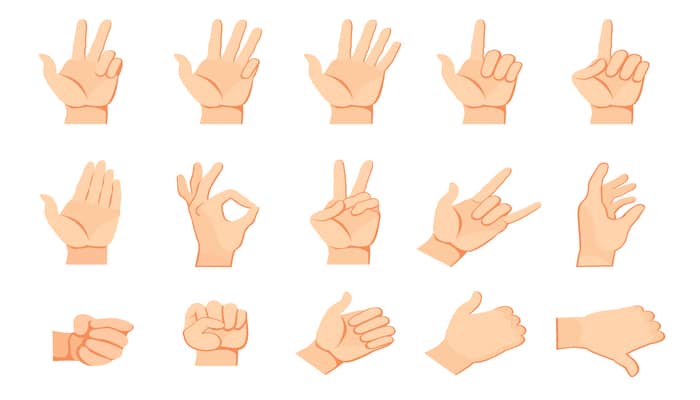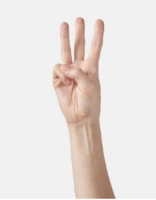
Whether you’re traveling abroad or just meeting new people, it’s always helpful to know what a person’s hand gestures mean. In this article, we’ll explore the meanings of different hand gestures around the world, including ones for hello and good-bye, gratitude, zero, please and thank you, numbers, and more. You’ll learn how to communicate with others in their native language by mimicking their body language with your own hands!
At Engmates we introduce hand gestures in our spoken English classes and interview preparation classes to enable our students to understand people of different cultures and countries better.
Hand Gestures for Hello and Good-bye

- Waving hello and goodbye: You can wave to someone you know or a stranger to say hello, goodbye, or that you’re leaving. The gesture can also be used to indicate the amount of time remaining in something, like how many minutes are left in class.
- Shaking hands: This is most commonly used by males. It usually means friendship or agreement on some level.
- Bowing: Bowing shows respect for another person and their position as well as indicating submission (e.g., if you bow before your teacher). If someone bows back at you after bowing yourself, it means they accept your submission.
- Nodding: Nodding is often used when greeting someone or showing agreement with them (e.g., saying “yes” out loud). It’s also used in place of saying “hello” or “goodbye,”, especially among people who don’t know each other very well yet because it’s less formal than shaking hands but still shows respect for authority figures like teachers/bosses/etcetera
Hand Gestures for Gratitude

- Hand on heart: In many parts of the world, this gesture is used to show gratitude. The person who did you a favor will often respond in kind, showing their appreciation and thanking you in turn.
- Pointing: An open palm with three fingers extended is the most common way people point at things, but pointing with just one finger can mean something different depending on where it’s done. For example, pointing at someone’s nose or face means “you” in some cultures; in others, it means “me”.
- Clapping: This gesture shows approval or appreciation for something another person has said or done. It can also be used to call for silence so that everyone can hear what’s being said by someone else—a form of applause without actually clapping!
- Bowing: Although bowing isn’t necessarily a hand gesture itself (it involves bending your upper body forward), it’s commonly used as an expression of gratitude when saying hello or goodbye to someone important like your boss or teacher at school.
Read More- How to Confidently Make an Appointment in English
Hand Gestures for Zero
The gesture for zero is a circle with the thumb and index finger. In many countries, this gesture has become the standard symbol for “zero” or “nothing.” It’s used in China, Japan, and other Asian countries as well as in France, Spain, and England.
Hand Gestures for Please and Thank you

If you are in a country that uses the palm-down gesture for please and thank you, it’s important to know how to use it properly. You want to make sure your palms are facing down toward your chest, not out toward someone else. It can be hard to tell if someone has their palms facing up or down when they’re far away from you, so try making eye contact while they do it and see what direction their hands are pointing in.
If someone asks you if they can have something (for example: “Can I have some water?”), hold up your thumb and index finger as if they were holding an invisible straw between them. This gesture means “as much as this” and is used all over the world—just like a thumbs up!
Hand Gestures for Numbers

- To count numbers, use your fingers. The number one is a fist; two is a single finger; three is a thumb and forefinger together (or any other combination of numbers); four is a hand with an index finger pointing up; five is a thumb and index finger touching (or any other combination of numbers).
Many languages have their own ways of expressing words or phrases using gestures. For example, in some countries, it’s common to use certain hand gestures when you’re speaking English or Hebrew. Some examples include:
- Thumbs up – Good luck!
Hand Gestures for “come here” and “go away”
- Pointing to someone or something
- Pointing to yourself
- Pointing at the ground
- Pointing at the sky
- Pointing at a clock to show the time
- Pointing at a calendar to show the date
Read More- 12 Powerful Words to Use When Interviewing
You Can Learn the Meaning of Hand Gestures to Communicate with People from Other Countries.
When you travel to other countries, you may find that hand gestures are used in place of words. Hand gestures can be used to communicate with people who do not speak your language. Learning the meaning of hand gestures can help you communicate with people from different cultures.
Conclusion
I hope that you’ve learned a few new hand gestures and are now ready to try them out with people in your own country. I think it’s important to remember that we can all use more opportunities to make friends with people from other countries, so don’t be afraid to reach out!
